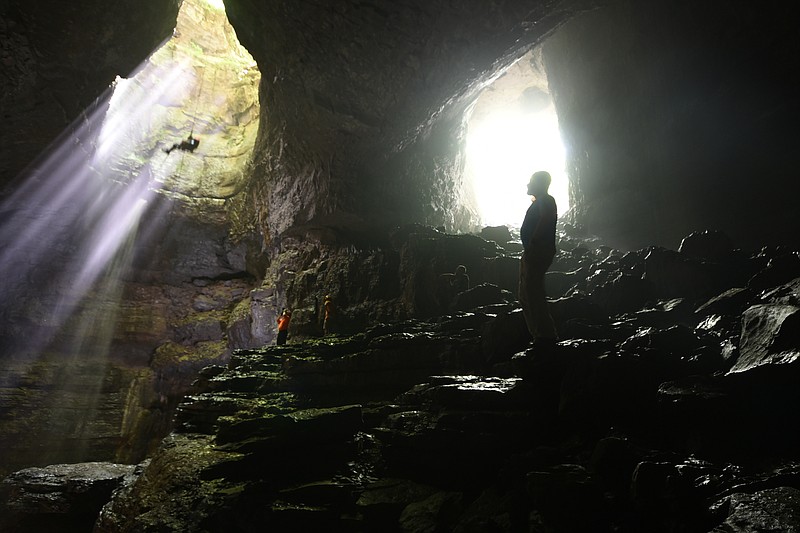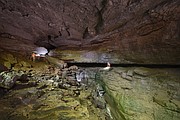Photo Gallery
Deep dedication: For 25 years, one local group has worked to preserve the region's vast network of caves
More Info
The Southern Cave Conservancy: www.scci.org
JACKSON COUNTY, Ala. - Many of the tri-state region's outdoor destinations stand out, greeting travelers with their natural beauty, preserved by conservation organizations or integrated commercially into the area's identity.
Below the surface, though, out of sight and out of mind to most, is the area's pristine underground.
The caves are less marketable than the lush playgrounds above them, but they are famous nonetheless, thanks in part to a Chattanooga-based organization that has protected caves and the areas around them since 1991.
The Southeastern Cave Conservancy Inc. is celebrating 25 years of preserving the underground of one of the world's most fertile caving areas: TAG, short for Tennessee-Alabama-Georgia.
"Everybody who is a caver pretty much anywhere in the world is aware of this region," said William Shrewsbury, president of the Alabama-headquartered National Speleological Society, a group with 10,000 members in 250 chapters.
Shrewsbury lives in Harrison, Tenn., and has been president of the NSS for five years. He's also a member of the SCCi, and praised the organization for its work in preserving the underground and educating those above on its importance.
SCCi also manages caves in Florida, Kentucky and West Virginia, but the tri-state region is its wheelhouse. It owns or leases 24 caving preserves in the region, many of them within a 90-minute drive of Chattanooga, such as Stephens Gap Cave just west of Scottsboro, Ala., a property acquired by the conservancy in 2014.
"We bought this as private property," SCCi executive director Ray Knott said Monday as he sat on a rock just feet away from a 140-foot drop into the cave. "That blows my mind. Somebody just owned this. It was theirs."
Knott is a new addition to SCCi. He's the conservancy's first full-time staffer, a non-caver with a nonprofit background, and an outsider's set of eyes. He oversees the land deals and navigates organizational management tasks so the 1,000-plus members and volunteer leaders can focus on their passion: the caves.
"It's great to have the non-caver perspective," SCCi Volunteer Marketing Manager Amber Lehmann said. "We can be a tight-knit circle and it's helpful to have Ray who can see things in a fresh light."
Lehmann recalled an SCCi 25th anniversary celebration and fundraising event at the Flying Squirrel bar in Chattanooga in early April. She said many of the patrons who came through were unaware of SCCi and the work it has done over the last two and a half decades.
"I think the biggest thing is that we have been so caver-centric for so long that we've sort of lived in our own bubble," said Lehmann, who moved to Chattanooga from the Washington, D.C., area to be closer to the caves. "So we're at the point where we really just want other people to know. The most important thing for an audience outside of cavers is just the importance of saving them and making people aware of what's underground and the importance of protecting it."
Many of the region's caves are home to endangered wildlife, including bat populations at risk for white nose syndrome, a disease that has claimed the lives of millions of bats in the last several years. The underground chambers also are valuable in geological, ecological and water research.
The SCCi management of preserves and recreational access to them varies based on the status of each cave. Some are remote and virtually inaccessible, or only attractive to hardcore cavers bent on strapping on a harness to descend hundreds of feet. Others, like Stephens Gap Cave, are widely visited because of the hiking opportunities on the preserve and the scenic view of a stream falling off the rocks into the gaping hole in the earth.
Visitation to caves on either end of the spectrum hinges on the status of the wildlife inside. Access to Howard's Waterfall Cave Preserve in Dade County, Ga., is open, while Frick's Cave in adjacent Walker County is only open one day per year due to its endangered bat population. Stephen's Gap Cave falls in the middle; visitors must obtain a permit before going.
"It's us just trying to balance," Knott said. "We want everyone to be able to enjoy all this as much as possible. At the same time, we want to save it for your kids, my kids and their kids."
The Johnson's Crook Cave Preserve, also in Dade County, is a recent example of the concept.
Slated at one point to become a real estate development in the mold of Pigeon Forge, the area's future came into question when the development failed.
Some worried the area might fall into the hands of miners or clear-cutters who would tarnish the area's natural beauty.
But in October, the Georgia-Alabama Land Trust announced a partnership with the Southeastern Cave Conservancy to create a cave preserve on the land, spanning 1,300 acres with 34 caves.
"You don't think about caves because they're not a big land mass," Georgia-Alabama Land Trust executive director Katherine Eddins said. "They're a hole. And a lot of people don't realize they're there, or they do and they don't realize their importance.
"So to have a group active in knowing they're there and preserving them is a great thing for our region."
Contact staff writer David Cobb at dcobb@timesfreepress.com or 423-757-6249.

